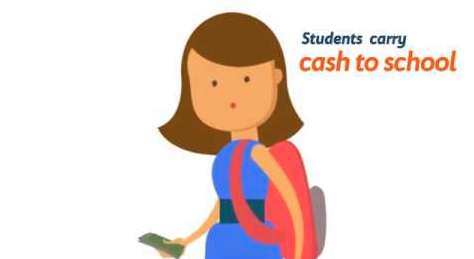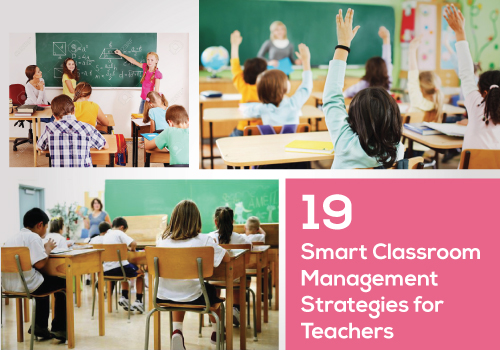Categories(658 Blogs)
Select Category
Watch Right Now
Teacher App - Class
Schedule & Attendance Management App
Parent App from Edsys

Best School Bus Tracking System

Cashless School - For Smart Schools of Tomorrow


19 Smart Classroom Management Strategies for Teachers

Grabbing students’ attention in a classroom is not easy for a teacher. Ideal classroom management strategies can help.
Getting students to stay interested and engaged in a classroom is not that easy. Classroom management issues are a great concern, especially for beginning teachers. Reliable smart classroom management strategies are crucial to create a successful learning environment, where students are free from disruptions, distractions and threats to safety and well -being.
Free Classroom Activity Apps (Check it Now)
Motivation plays a crucial part in managing students. While intrinsic motivation is a response to needs that exist within the student, extrinsic motivation refers to external rewards on the completion of a task.
Must Read: Top 12 Classroom Management Tips
Relevance of Classroom Management is Important to –
• Create a positive learning environment that students feel safe
• Manage class time most effectively
• Engage students in lectures thus boosting confidence
• Organized learning opportunities
• Manage classroom resources in an effective manner
Optimize Student Learning and Achievement with These 19 Strategies
These strategies also impact the student’s life outside of the classroom.
1. Maintain Positive Attitude
Be positive minded. Teach each lesson with a positive mind frame. A negative approach towards your students can provide negative results. Be strict, but be positive. However, too much control can spoil everything.
2. Use Some Signals to Get Attention
Teachers can use any word, signal or sound to grab student’s attention during class. Popular signals include hand signal, where teacher raises his/her hand and waits for complete silence in the classroom, bells, whistles, turn off the lights, or even claps. Make sure not to continue with your lessons until all the students listen to you.
3. Make Changes in Seating Arrangement
Changes in the seating chart can bring in the discipline in your class. It is the cheapest form of managing our class. Make sure to seat the children where their attention is directed towards you. They should be able to clearly see board and screens as well.
4. Update your Lesson Plan
You should also learn the skills you need to successfully plan and teach motivating lessons. Updated lessons and course structure is essential to the process of teaching and learning. A new teacher must be ready to spend the necessary time developing interesting lessons.
5. Give and Take Respect
To be respected by your students you should also respect them. A warm, personal greeting for each student at the beginning of the day and a farewell at the end would be good. Also, have the general talk with them. Know what the student does at home. Do he read, plays games or even watch TV.
You May also Like: Tips to Make Classrooms a Better Learning Place
6. Get them Involved in Extracurricular Activities
You can arrange some extracurricular activities outside the classroom at regular intervals. Evaluate the games your students enjoy the most. Ask every student to participate in those activities in one or the other way. This will also help the students to realize that you are there to encourage them.
7. Compliment positive Behaviors
Instead of correcting a student’s negative attention, ignore his behavior and praise the students. While praising the hardworking student, the other students will most likely copy the model student’s activities so that the teacher will also praise him.
8. Silence is the Right Tool
Shouting at the unruly students will be of no use. It is ideal to use a calm and quiet voice, which reflects your emotions and tone. By remaining silent, students will realize that their teacher values their conversation and respect them to let them finish.
9. Create a Guideline for Disciplinary Measures
Your students should have enough freedom in their class. But at the same time, they should be aware of the after effects of certain actions. When they know what repercussions come with certain behaviors, they are less likely to act out.
10. Balance Friendliness and Position
Maintain the right mix of authority and friendship in your class. Be friendly to your students and advise them in difficult situations. But remember you are the authoritative figure in the room.
11. Stick to the Decided Rules
If you are not ready to follow the rules you set, how your students would follow. Never compromise in the decided measures. Stay steady with your student discipline approach. This will help in stopping students from repeating offenses.
12. Punish the Right Candidate
It would never be fair to punish an entire class, even if it seems that all of them are misbehaving. Choose the right kids who are providing directions. Punishing the class as a group only provokes further conflict.
13. Bring Hard Situations to Light
Handling problematic situations would be difficult for a beginner. In certain cases, talking to the students’ parents will be the right action to take. You can also take help from experienced colleagues.
14. Change the Possible, Leave the Rest
Your class may not be perfect when compared to others. That doesn’t mean that they are not learning. Certain things may be out of your control. Don’t be scared to experiment. Try to turn the negative to positive. Don’t worry about the rest.
15. Try Creative Activities
Make students do creative activities. Provide them ideas. Guide them how to do. For instance, you can make them hang seasonal symbols in the classroom for each season. Celebrate each time they get a compliment from staff member or a visitor.
16. Teach them Social Skills
Teach them social skills such as raising hands, taking turns and sharing them as a part of the learning course. Provide reminders so that they will remember the taught skills.
17. Identify each Student’s Strength
Create opportunities to reveal each kid’s hidden talents and interests. Make sure the student is prepared to exhibit his expertise in the subject.
18. Use Simple Language
The classroom is not the place for teachers to exhibit their language fluency and expertise. Talk to students in a very simple language so that they will clearly understand your instructions. This improves their confidence as well.
19. Provide more Visual Content
Rather than theory, it is far better to use visual aids like charts, images and graphs. Visuals will stay in their mind for a long time than just text materials.
Remember that the major principle behind classroom management is to deal with students’ disruptive behavior and teaching them how to manage their own behavior.
Recent Blogs
Our Educational Services
Popular Blogs
Subscribe

SUBSCRIBE TO OUR NEWSLETTER
Sign Up and Recieve the Latest News
Don’t Worry, We Don’t SpamExplore Our Extensive Researched Educational App Directory
Visit Now















